
To the infinite possibilities in 2009!!!

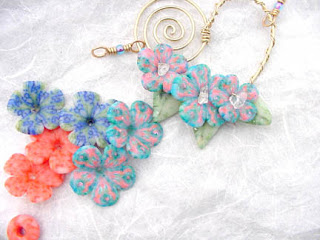
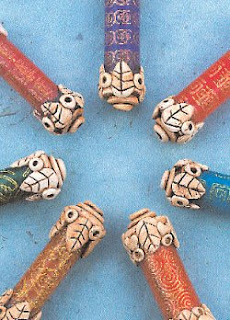 I have great luck with metals, glass, polymer clay, some plastics, and fabrics. They are translucent, so color shows through them, especially on the lighter colors.
I have great luck with metals, glass, polymer clay, some plastics, and fabrics. They are translucent, so color shows through them, especially on the lighter colors.
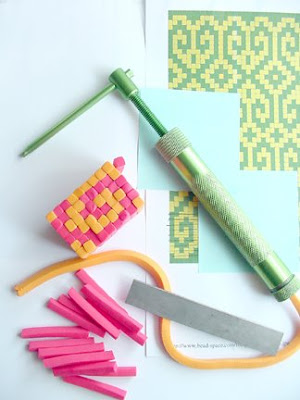
 Now you are going to use sticky notes and block off a section of the pattern like I have done, shown in the first picture above. Now assemble the squares to duplicate this pattern exactly. Place all the square logs together deliberately and take your time to make sure they are all lined up. Once you get the block together. Start compacting the lined sides (all of them one at a time) of the block down gently to extend the patterned faces out and lengthen the design block and make it smaller in size. Go slow and do a little at a time to keep the rectangle shape and the pattern straight.
Now you are going to use sticky notes and block off a section of the pattern like I have done, shown in the first picture above. Now assemble the squares to duplicate this pattern exactly. Place all the square logs together deliberately and take your time to make sure they are all lined up. Once you get the block together. Start compacting the lined sides (all of them one at a time) of the block down gently to extend the patterned faces out and lengthen the design block and make it smaller in size. Go slow and do a little at a time to keep the rectangle shape and the pattern straight. 
 o make the design more and more complicated.
o make the design more and more complicated. 

 Brass wire and I make a hook on one end and an eye on the other.
Brass wire and I make a hook on one end and an eye on the other.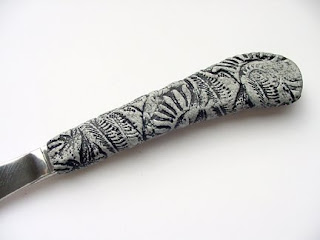
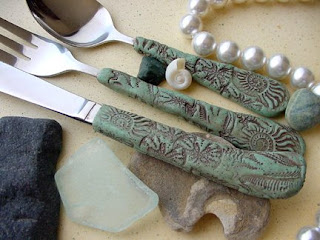
Here is the Basalt and because it is green, it is naturally a favorite of mine.
Cernit is a wonderful clay to make silverware with because of the hard and dense surface after baking. I also used Black Ne-opaque acrylic paint as an "antiquing medium" for the top handle in granite and Brown for the handles in Basalt color.
Rubber stamps courtesy of http://www.rubberstampplantation.com/ Thanks Deb!!!
And for what is so cool about the color Granite...
 One clay, oh so many choices!!! There are just 7 here. The possibilities are infinite. This formulation is 1 part Granite and 1/4 part color Cernit of choice. These colors remind me of that wonderful 50's floor tile.
One clay, oh so many choices!!! There are just 7 here. The possibilities are infinite. This formulation is 1 part Granite and 1/4 part color Cernit of choice. These colors remind me of that wonderful 50's floor tile.
Because of the nature of the Nature colors, they are better for this type of application. For caning, layered stacks, mokume gane, and millefiori techniques you are better off starting with the Opaque white and mixing in embossing powders for that. Anytime you are cutting cross sections of the clay, the fibers and particles in the Nature colors will load up on the blade and sometimes drag across the surface or face of the image. Opaque white Cernit with black, gray, and gold embossing powder will give you a similar look. Some places even have Granite embossing powder with a varied mix of powders sold as the color. You can tint that too!!! OMG!!! I love oven-bake polymer clay!
Do you have some crummy silverware that needs a face lift? Wouldn't this make a wonderful gift? Bought my silverware at Smart and Final.
 As long as I am on the extruder thing, I thought I would post this. You can use this for twisted beads using the bead corers if you want, but I am just going to show how to make a rope the easy way.
As long as I am on the extruder thing, I thought I would post this. You can use this for twisted beads using the bead corers if you want, but I am just going to show how to make a rope the easy way. Screw down the handle of the extruder until the clay starts coming out the end of the extruder, continue until you have extruded all of the clay out of the gun. It does about 12". Cut in to 4" pieces for easier control and to practice with. Hold one end of the extruded cloverleaf and with your other hand and roll the other end gently away from you. This will twist up the cloverleaf and you will have a rope just like that.
Screw down the handle of the extruder until the clay starts coming out the end of the extruder, continue until you have extruded all of the clay out of the gun. It does about 12". Cut in to 4" pieces for easier control and to practice with. Hold one end of the extruded cloverleaf and with your other hand and roll the other end gently away from you. This will twist up the cloverleaf and you will have a rope just like that. 
 an 1/8" thick and fold the clay in half to double the thickness, then you can cut out a shape with a cutter. The cutter I am using here is a 1" round Kemper cutter, yes, you heard me right they make them now. Sometimes Howard needs to be booted in the pants to get him load things up on the website, so you just write him at order(at)clayfactory.net and tell him you would love to have one of those 1" round kemper cutters. Substitute that word (at) for the sign. Tell him Marie sent you.
an 1/8" thick and fold the clay in half to double the thickness, then you can cut out a shape with a cutter. The cutter I am using here is a 1" round Kemper cutter, yes, you heard me right they make them now. Sometimes Howard needs to be booted in the pants to get him load things up on the website, so you just write him at order(at)clayfactory.net and tell him you would love to have one of those 1" round kemper cutters. Substitute that word (at) for the sign. Tell him Marie sent you.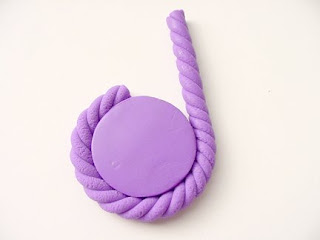 Once you have the shape, then you take the rope and place it around the shape. Cut the leading edge of the rope with your clay blade for straight edge first.
Once you have the shape, then you take the rope and place it around the shape. Cut the leading edge of the rope with your clay blade for straight edge first.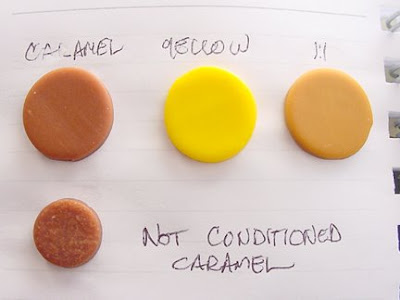
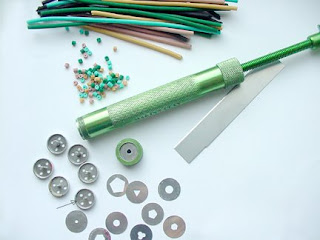

 Here you can see the clay starting to come out of the hole in the disk. Continue to screw down the handle and the clay will keep coming out. Do this until all the clay is out of the gun and you can not move the handle anymore.
Here you can see the clay starting to come out of the hole in the disk. Continue to screw down the handle and the clay will keep coming out. Do this until all the clay is out of the gun and you can not move the handle anymore.You take an 1/8 block of 7 colors of Cernit, violet, blue, light green, yellow, orange, red, and turquoise and you mix it, 1 part to 1 part, with 010 white (porcelain). Mix the clay completely till it is one color. Take a 3/4" ball of each of the colors and roll into a coil that is 3 1/2" by 1/4" in diameter.

 With a clay blade cut each of the powder covered coils in half and flatten one of the halves in to a teardrop shape.
With a clay blade cut each of the powder covered coils in half and flatten one of the halves in to a teardrop shape.
 Here are all of the coils after I have covered them with Aztec Gold Pearl-ex powder. Now wash your hands really well or change gloves if you wear them. Get yourself an old towel to wipe your hands off with later too.
Here are all of the coils after I have covered them with Aztec Gold Pearl-ex powder. Now wash your hands really well or change gloves if you wear them. Get yourself an old towel to wipe your hands off with later too.

 Ochre or Ocher (pronounced /'əʊ.kə(r)/, from the Greek ὠχρός, yellow) is a color, usually described as golden-yellow or light yellow brown.
Ochre or Ocher (pronounced /'əʊ.kə(r)/, from the Greek ὠχρός, yellow) is a color, usually described as golden-yellow or light yellow brown. 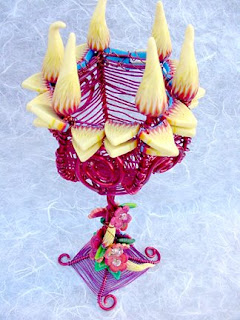
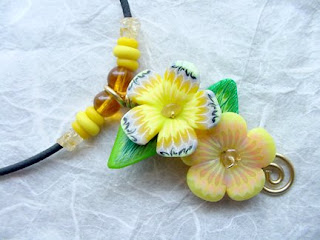 have 3 variations of the same color and when baked they all work together (after all, they are the same color, wonderful for those of you that think you don't know how or are afraid to mix colors), but I have a variation of the same color for a more dramatic effect, as in the flames of the goblet above. Here is another view of the yellows. I have used more than one yellow color and its variations in the flowers though.
have 3 variations of the same color and when baked they all work together (after all, they are the same color, wonderful for those of you that think you don't know how or are afraid to mix colors), but I have a variation of the same color for a more dramatic effect, as in the flames of the goblet above. Here is another view of the yellows. I have used more than one yellow color and its variations in the flowers though.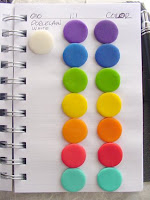 Here is an example of a rainbow of colors mixed one to one with the porcelain white 010 or what they just call white.
Here is an example of a rainbow of colors mixed one to one with the porcelain white 010 or what they just call white.

 the skulls. I prefer a kind of stiff brush like this to get in to the cracks and the eye sockets. I cover all the skulls I have with paint this way, or if I have a lot, I do 10 at a time and then I take a ratty old dish towel, dampen it (key word dampen, not soak) and wipe off the excess paint. I then drill the holes in the side of the heads and wire in to my pieces.
the skulls. I prefer a kind of stiff brush like this to get in to the cracks and the eye sockets. I cover all the skulls I have with paint this way, or if I have a lot, I do 10 at a time and then I take a ratty old dish towel, dampen it (key word dampen, not soak) and wipe off the excess paint. I then drill the holes in the side of the heads and wire in to my pieces. 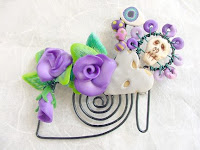
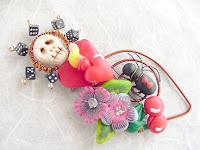 "cempasúchitl" (originally named cempoalxochitl, Nahuatl for "twenty (i.e., many) flowers"). In modern Mexico this name is often replaced with the term "Flor de Muerto" ("Flower of the Dead"). These flowers are thought to attract souls of the dead to the offerings.
"cempasúchitl" (originally named cempoalxochitl, Nahuatl for "twenty (i.e., many) flowers"). In modern Mexico this name is often replaced with the term "Flor de Muerto" ("Flower of the Dead"). These flowers are thought to attract souls of the dead to the offerings.
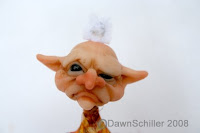
 china paints. And the smiling friendly guy is made from what the Cernit clay people call biscuit. It is a color very much like bisque porcelain clay, they really did a wonderful job with this new formulation of Cernit. They kept the colors and the porcelain effect intact with out all of the weird things that Cernit used to do. LOL!!! it looks like mug shots for gnomes, ogres, goblins, and oddfae...perfect for the Halloween holiday. The Biscuit, Champagne, and Flesh colors are all excellent for making dolls and faces, hands, body parts, and feet.
china paints. And the smiling friendly guy is made from what the Cernit clay people call biscuit. It is a color very much like bisque porcelain clay, they really did a wonderful job with this new formulation of Cernit. They kept the colors and the porcelain effect intact with out all of the weird things that Cernit used to do. LOL!!! it looks like mug shots for gnomes, ogres, goblins, and oddfae...perfect for the Halloween holiday. The Biscuit, Champagne, and Flesh colors are all excellent for making dolls and faces, hands, body parts, and feet.